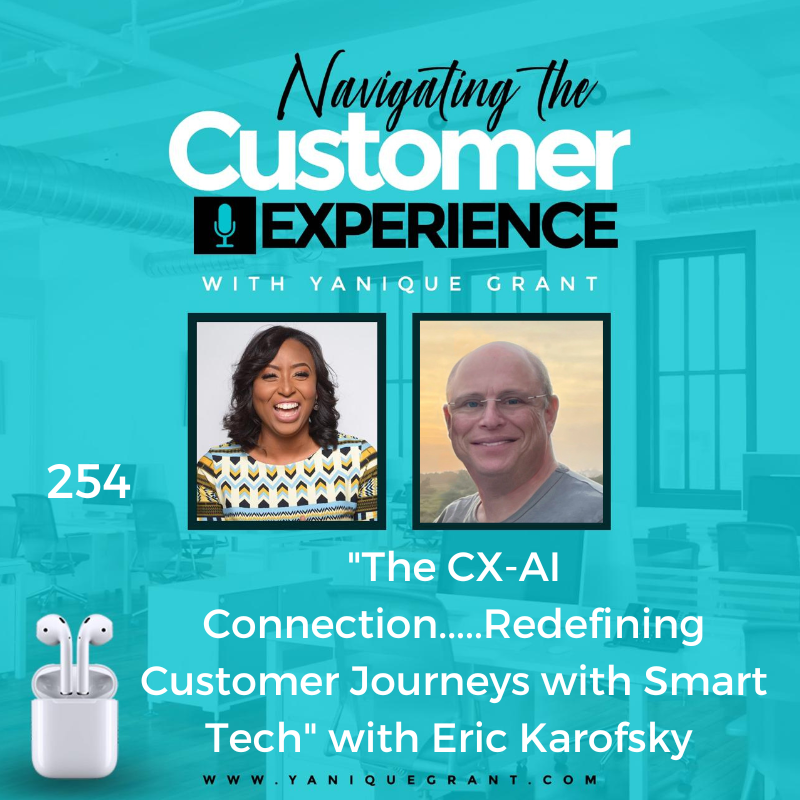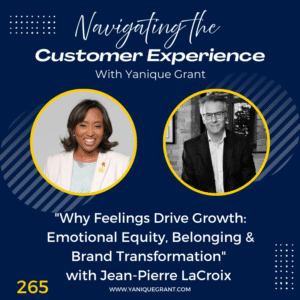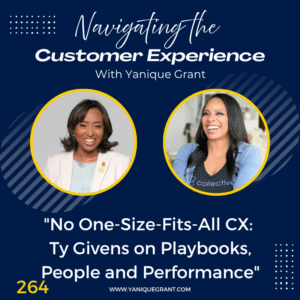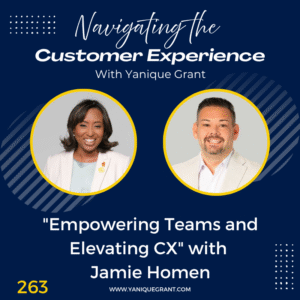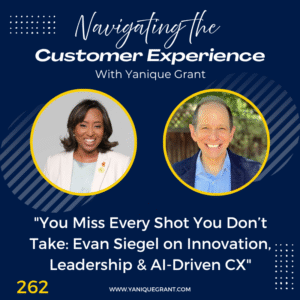Eric Karofsky is an award-winning CX, UX, and employee engagement industry expert who leads VectorHX, a human experience agency.
Questions
- Now, Eric, can you share with our listeners a little bit about your journey, how you got from where you were to where you are today?
- If you were to identify maybe two or three overarching themes that you believe has been an influential driver for customer experience based on interactions that you’ve had with your customers, as well as an industry expert, what would those two to three overarching themes be?
- Should customer communication channels be shaped by cultural preferences—like Jamaica’s tendency toward phone interactions—or if organizations should guide customers toward more efficient channels, such as chat, even if it’s not their natural choice?
- How should AI capabilities drive business strategy, and can you provide an example of a customer who has successfully done this?
- Could you also share with us what’s the one online resource, tool, website or application that you absolutely can’t live without in your business?
- Now, can you share with us maybe one or two books that you have read, it could be a book that you read a very long time ago, or even one that you’ve read recently, but it has had a great impact on you.
- What helps you stay motivated and driven as a business owner, especially on challenging days?
- Can you also share with our listeners what’s the one thing that’s going on in your life right now that you’re really excited about, either something you’re working on to develop yourself or your people?
- Where can listeners find you online?
- Now, before we wrap our episodes up, we always like to ask our guests, do you have a quote or a saying that during times of adversity or challenge, you’ll tend to revert to this quote if for any reason you get derailed or you get off track, the quote kind of helps to get you back on track. Do you have one of those?
Highlights
Eric’s Journey
Me: Now, Eric, can you share with our listeners a little bit about your journey, how you got from where you were to where you are today?
Eric shared that for about 20 to 25 years, he’s been in the agency and consultancy world, and he’s led very large projects for brands like Michelin, Royal Caribbean, Fidelity and others. And he’s went through some great experiences there, built some very great properties, and realized he never went client side. So, his next step, he ended up going to the Broad Institute of MIT and Harvard, which, if you don’t know of it, is just an amazing, amazing organization. They study DNA, RNA, Proteins, and they try and understand the cause for disease. It’s a pretty large organization, and he ran user experience for them and helped develop all of the different ways that they analyze the human genome and other genomes.
And then for about two and a half years, he’s been off on his own, starting VectorHX and building it, and it’s been great. And what VectorHX does is pretty straightforward, they make sure that when you interact with a business, whether it’s through a website, app, in person, phone or chat, it’s smooth and enjoyable, and it’s been a great ride so far.
Me: You said, before we actually started the recording that you’re based in Boston, do you only serve customers in the United States, or is your business open globally, like you serve customers all over?
Eric shared that they currently only serve clients in the US, there’s no reason that we couldn’t do it larger, more expansive, but currently only US.
Influential Driver for Customer Experience
Me: Now, customer experience is continually an area that is transforming, customers behaviors, their expectations, their needs. I know almost the first quarter of 2025 is finished, and we’re barreling fast towards the end of the second quarter, if you were to identify maybe two or three overarching themes that you believe has been an influential driver for customer experience based on interactions that you’ve had with your customers, as well as an industry expert, what would those two to three overarching themes be?
Eric shared that AI, obviously, is just a huge theme, it’s attacking us from so many different ways, and it’s something that he’s genuinely very excited about. He hears a lot of people that are concerned, and he gets the concern, but to him, it just seems like there’s a lot of opportunity. It’s a tool, it’s not a solution. So, when you start thinking about it as a tool, that means it begs you to want to learn about the tool more and figure out, how do you utilize it to the best of its advantages and the best of your advantages. So, to him, it’s just a great opportunity.
One of the other trends that he sees a lot is just and maybe the bad side of the AI is people just jumping so quickly into chat. He’s seeing a lot of companies, obviously into chat, and so far, except for a few, they’re pretty rough experiences. So, him as a consumer, it’s almost like the call centers of the 80s where you get stuck in these awful loops just talking to computers, and you know you’re talking to computers, and all it does is increase frustration. So, that’s something that he’s looking forward to, people that have implemented chat improving their chat experience.
Balancing Cultural Preferences and Channel Efficiency in Customer Communication
Me: Do you find like, for example, in Jamaica, we’re still a heavily telephone interaction driven society. But I know when I do research, I’ve seen that, like other Caribbean territories, they are more like data driven, meaning their customers will more maybe want to log on to a chat to have a conversation, whereas a Jamaican would more take up the phone and want to physically have a conversation with someone. In your experience, do you believe that that is cultural, and do you think organizations should focus on trying to get their customers to a particular channel to communicate with the company, or should it be organic, where the customer just goes into that channel based on what they naturally feel comfortable with?
Eric stated that that’s a great question. So, certainly, it is cultural. It also is situational, and it’s demographic based. The real thing that he counsel companies, is to understand their personas and understand the journeys that those personas want to go through for different sorts of situations. So, himself as a consumer, sometimes he wants to pick up the phone and talk to somebody if he feels it’s more complicated or sensitive in some manner. And sometimes it’s nice to be able to do it by chat, while he’s working, he just has a chat window open. But us as customer experience folks, he thinks we really need to understand what is that ideal journey, not to force them down one path and make sure that whatever channel that they choose works brilliantly for them.
Integrating AI Capabilities into Business Strategy with Real-World Examples
Now, you mentioned a little bit about AI earlier as one of the driving trends in customer experience, if we take a little bit of time to kind of just talk about AI leadership and maybe just explain for us how AI capabilities should be driving strategy in businesses. And maybe give us an example if you have a customer who has done that.
Eric shared that again, he kind of thinks about AI as a tool, and it does some things really well, some things not as well. Albeit, it seems almost every week it’s doing another thing really, really well, it’s just moving so incredibly fast. But understanding all of the capabilities, understanding all of the places that you can go ahead and find efficiencies becomes really important.
So, one place that he’s working with right now is one of the large pharmaceutical companies, and they do a lot in the beginning of their research, they do these things called literature reviews. And what a literature review is they have some sort of scientific question that they want to understand a disease or a demographic or some sort of interaction, and they work with a vendor to go ahead and comb through all of the different literature over the past X amount of years.
And they can come up with hundreds of different articles from different journals, all academic papers. They then go ahead and sift through those to find out what are the articles, and it’s usually about 100 or so, or might be about 100 or so. And then what that vendor does is they read through that, and they take every single data point in those articles, or many different data points in those articles, because they’re defined what they’re specifically looking for, and they transpose that into an Excel document. And these Excel documents are hundreds of columns long, hundreds of rows deep, and that might just be for one journal. They are massive efforts, and they take anywhere from about six months to do and about $250,000. So, this is a perfect case for AI.
So, he’s working with them right now is going through, how do we train the AI models to go ahead and review all of those publications, many of them are public. Review all of those, automatically have the AI suggest which of the articles might be more relevant than others. And then a human goes ahead and approves it. Then the AI goes ahead and takes all of the information and inputs it into a spreadsheet or some sort of other mechanism, and then what the human does is validate that the AI got it right.
So, what they’re doing is they’re moving it from about six months initially down to about two months. And the reason for that two months is because the human is validating a lot of the information. They anticipate, as that validation gets better, and as they continue to train those models, they’re going to get it down to about two weeks. So, it’s over like a 95% improvement in both time as well as cost.
Me: And efficiency, if you’re cutting time down, you get more efficient.
Eric agreed, absolutely and stated that he shouldn’t have really even stopped there of saying it’s the 95% improvement, because that’s great, and that’s wonderful. And therefore, the company maybe can make some more money, the pharmaceutical company. The real benefit is it takes about 10 to 15 years to bring a drug to market. And McKinsey has recently done some research and found that scientists spend about 20% of their time looking for documents and looking for information, if AI can start shrinking that time, and throughout the entire drug development life cycle, we’re talking almost about a year and a half shorter in getting a drug to market. That means families benefit a year and a half sooner to see their loved ones cured or benefiting from some sort of medicine. And that’s the real result that we’re looking at.
Me: Agreed, treatment gets to market faster, which helps more people. Brilliant. I like that example. Thank you so much for sharing, Eric.
App, Website or Tool that Eric Absolutely Can’t Live Without in His Business
When asked about an online resource that he can’t live without in his business, Eric shared that one of the AI models, he usually jumps between many of them, the one that he’s been using mostly right now is Claude, and he uses it for a lot of different things. He finds it enormously beneficial, almost like a partner that he interacts with, ask questions, and then he take its answers and make them more useful for his needs. So, that’s one of them.
He also uses Notion a lot. He finds Notion really, really good. He built a solution, a bunch of different interactions, if you know Notion, that manages his business and tracks all the conversations he’s having, etc.
Books that Have Had the Biggest Impact on Eric
When asked about books that have had an impact, Eric stated that he’ll say the things that have helped the most, they’re back in business school, and was probably the best business school class he ever took, and that was negotiation, just basic negotiation tactics. And there’s a whole bunch of books in there that are relevant. It’s hard to say one that is better than another. Getting to Yes: Negotiating Agreement Without Giving In is one that he remembers that he really liked. So, he thinks for listeners, any sort of negotiation tactics that you can learn about are really helpful, and they really help in not just getting a better deal, but just help you have a better, more pleasant, more mutually beneficial negotiation.
Another one, which is an older book, is by Don Norman, The Design of Everyday Things. That’s another book that he really likes. And you might think it’s just about product design, but it really talks about customer friction and how to go ahead and get above customer friction. So, in his UX life, he certainly remembers components of it and leverage different components of the learnings. But as a customer experience person, it’s just as beneficial.
Maintaining Motivation and Resilience as a Business Owner Through Entrepreneurial Challenges
Me: As a business owner, could you share with our listeners maybe one or two things that you do that helps you to stay motivated every day, because we’re human and there are days when we might not feel as engaged or as energized, and on those days, what really drives you to keep going?
Eric stated that there’s so much going on in the space that he’s lucky enough to participate in. He mentioned it before with AI, there’s just so much going on and so many ways to leverage it that people really haven’t thought of, or they’re just starting to touch on. So, it feels so much to him of the internet boom back in the early 2000s where there was a new site coming out every day that did something new that you never thought was possible. To him, that’s what’s going on now. So, that generally gets him excited.
He also finds that working with different people and being just generally interested in those people as individuals is something that gets exciting for him. Understanding what motivates them, understanding what they’re looking to get out of their job, and this goes for clients as well, just building relationships with them, he thinks that’s just a place for inspiration and generates excitement for him.
What Eric is Really Excited About Now!
When asked about something that he’s really excited about, Eric stated that continuing the AI thread, there are some apps out there, the Vibe apps, the No-Code apps like Bolt.new and Lovable, he finds absolutely amazing. So, for those that haven’t used them, he urges you to go ahead and do the free sign up. They give you a certain amount of credits, and what you’re doing is it’s all no code, so you just explain what you want, kind of like what you’re using with chat GPT.
You need to have the right type of prompt, or the better prompt usually gets a better result. But you just tell it what to do, and it builds a full stack application, and it’s incredible.
And he’s built a few of these applications, and he’s modified them, confirm with them. And one of them has been a resource that he uses in his business, and another one is a resource that he uses in when he’s not working and not with my family, he’s down in a wood shop. He does a lot of woodworking, and one of the tools was for woodworking, and it’s just incredible these tools that are out there now.
Where can listeners find Eric online?
Website – https://www.vectorhx.com/
LinkedIn – Eric Karofsky
Quote or Saying that During Times of Adversity Eric Uses
When asked about a quote or saying that he tends to revert to, Eric shared that there’s one quote that that he likes and it’s one that we all know, Benjamin Franklin, “Tell me and I forget. Teach me and I remember. Involve me and I learn.”
And that’s when he thinks about a lot, especially as owning a business and bringing people in. And the better that he can take people that are more junior and teach them up and give them skills and really involve them that benefits him, his client, and certainly the person that’s working for him at the moment. So, that’s something that’s always kind of in the back of his mind.
Me: Well, Eric, we are at the end of our interview. We just want to extend our deepest gratitude to you for taking time out of your busy day to hop on our podcast and share some of these awesome insights about your journey, about your organization, VectorHX, and just a little bit about artificial intelligence and what it’s really doing, and that we really only have touched the surface of what it has the potential to do. And just a little bit of your insight on experiences that you’ve had with organizations that you’ve worked with, as well as just some predictions as to where you see the possibility of AI taking us. So, it was a great conversation, and I just want to say thank you again.
Please connect with us on X @navigatingcx and also join our Private Facebook Community – Navigating the Customer Experience.
Links
- Getting to Yes: Negotiating Agreement Without Giving In by Roger Fisher
- The Design of Everyday Things by Donald Norman
The ABC’s of a Fantastic Customer Experience
Grab the Freebie on Our Website – TOP 10 Online Business Resources for Small Business Owners
Do you want to pivot your online customer experience and build loyalty – get a copy of “The ABC’s of a Fantastic Customer Experience.”
The ABC’s of a Fantastic Customer Experience provides 26 easy to follow steps and techniques that helps your business to achieve success and build brand loyalty.
This Guide to Limitless, Happy and Loyal Customers will help you to strengthen your service delivery, enhance your knowledge and appreciation of the customer experience and provide tips and practical strategies that you can start implementing immediately!
This book will develop your customer service skills and sharpen your attention to detail when serving others.
Master your customer experience and develop those knock your socks off techniques that will lead to lifetime customers. Your customers will only want to work with your business, and it will be your brand differentiator. It will lead to recruiters to seek you out by providing practical examples on how to deliver a winning customer service experience!

